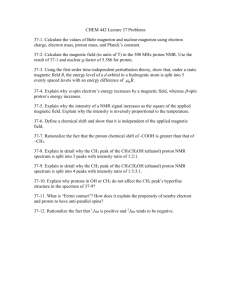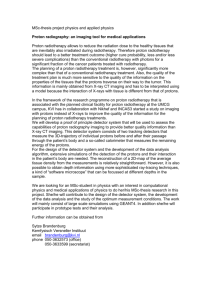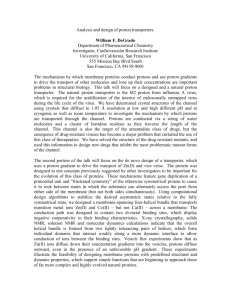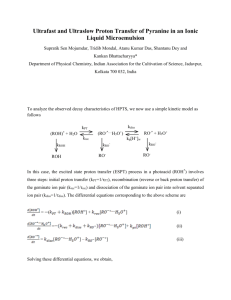to read the full announcement(Word, 47.68 kB)
advertisement
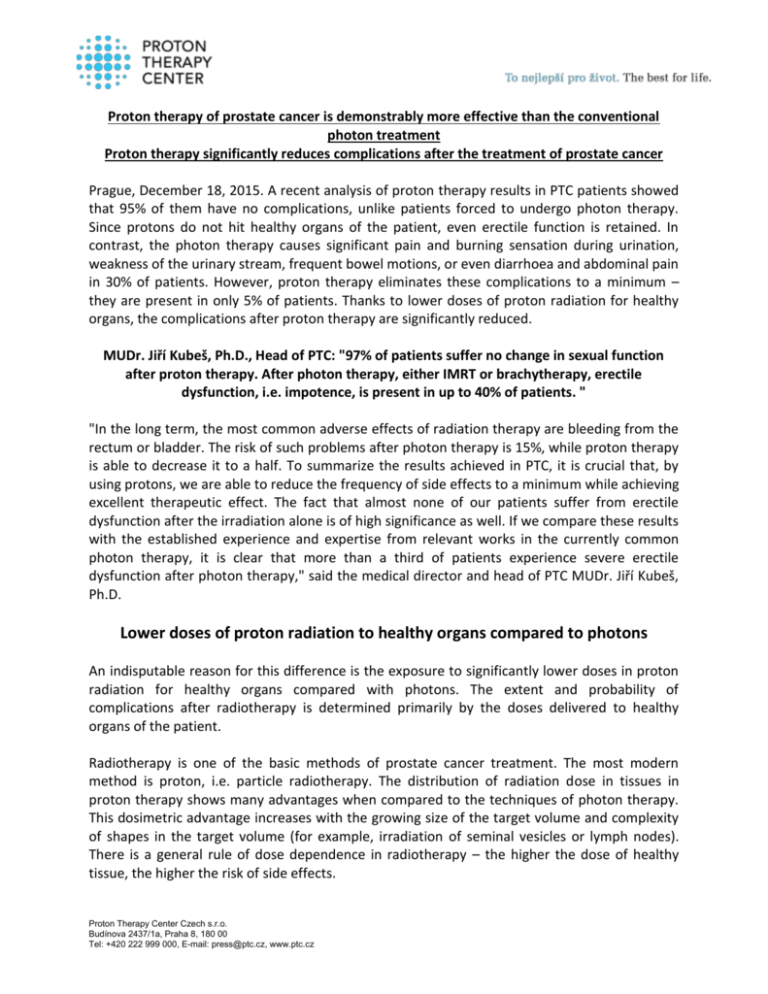
Proton therapy of prostate cancer is demonstrably more effective than the conventional photon treatment Proton therapy significantly reduces complications after the treatment of prostate cancer Prague, December 18, 2015. A recent analysis of proton therapy results in PTC patients showed that 95% of them have no complications, unlike patients forced to undergo photon therapy. Since protons do not hit healthy organs of the patient, even erectile function is retained. In contrast, the photon therapy causes significant pain and burning sensation during urination, weakness of the urinary stream, frequent bowel motions, or even diarrhoea and abdominal pain in 30% of patients. However, proton therapy eliminates these complications to a minimum – they are present in only 5% of patients. Thanks to lower doses of proton radiation for healthy organs, the complications after proton therapy are significantly reduced. MUDr. Jiří Kubeš, Ph.D., Head of PTC: "97% of patients suffer no change in sexual function after proton therapy. After photon therapy, either IMRT or brachytherapy, erectile dysfunction, i.e. impotence, is present in up to 40% of patients. " "In the long term, the most common adverse effects of radiation therapy are bleeding from the rectum or bladder. The risk of such problems after photon therapy is 15%, while proton therapy is able to decrease it to a half. To summarize the results achieved in PTC, it is crucial that, by using protons, we are able to reduce the frequency of side effects to a minimum while achieving excellent therapeutic effect. The fact that almost none of our patients suffer from erectile dysfunction after the irradiation alone is of high significance as well. If we compare these results with the established experience and expertise from relevant works in the currently common photon therapy, it is clear that more than a third of patients experience severe erectile dysfunction after photon therapy," said the medical director and head of PTC MUDr. Jiří Kubeš, Ph.D. Lower doses of proton radiation to healthy organs compared to photons An indisputable reason for this difference is the exposure to significantly lower doses in proton radiation for healthy organs compared with photons. The extent and probability of complications after radiotherapy is determined primarily by the doses delivered to healthy organs of the patient. Radiotherapy is one of the basic methods of prostate cancer treatment. The most modern method is proton, i.e. particle radiotherapy. The distribution of radiation dose in tissues in proton therapy shows many advantages when compared to the techniques of photon therapy. This dosimetric advantage increases with the growing size of the target volume and complexity of shapes in the target volume (for example, irradiation of seminal vesicles or lymph nodes). There is a general rule of dose dependence in radiotherapy – the higher the dose of healthy tissue, the higher the risk of side effects. Proton Therapy Center Czech s.r.o. Budínova 2437/1a, Praha 8, 180 00 Tel: +420 222 999 000, E-mail: press@ptc.cz, www.ptc.cz Proton radiotherapy for prostate cancer is provided in all the international proton centres "Proton therapy is a globally accepted method for the treatment of prostate cancer," according to Jiří Kubeš, who adds: "Proton radiotherapy for prostate cancer is provided in all the international proton centres. All the centres, world leaders in oncology, have it in their basic indication lists." Proton therapy has a higher success rate compared to photon therapy "The study and the results of proton therapy in the Proton Centre in Prague confirm the 97% success rate. Conventional photon therapy lasts for up to 41 days. Proton therapy takes only 5 days on an outpatient basis and is therefore more economical, saves the costs for the insurance companies and self-payers, and, last but not least, it is more pleasant for the patient," according to Iva Taťounová, the director of PTC. Reasons for proton radiotherapy for professionals: 1. Proton radiotherapy is a highly effective method. The probability of cure measured as 5-year PSA relapse-free survival according to recent published data for low- and medium-risk prostate cancer is higher than 95%. Such results are usually not achieved using photon techniques or surgeries. 2. Proton radiotherapy is associated with minimal toxicity. The last published papers on large cohorts found severe treatment toxicity in less than 1% of patients. In comparison with the published data on photon radiotherapy and surgical interventions, this toxicity level is minimal and significantly lower than for the other methods. 3. Compared with surgical therapy, proton therapy does not lead to urinary incontinence, thus saving the costs spent on managing this issue. 4. Compared with surgical therapy, proton radiotherapy does not lead to impotence, thus significantly improving the quality of life of patients. 5. Proton therapy, compared with brachytherapy, has a significantly lower risk of the development of urethral stenosis and impotence. 6. Proton radiotherapy is a fully outpatient treatment method. In most cases, it does not require sick leave. For low- and intermediate-risk prostate cancer, 5-day stereotactic proton irradiation can be used. Proton Therapy Center Czech s.r.o. Budínova 2437/1a, Praha 8, 180 00 Tel: +420 222 999 000, E-mail: press@ptc.cz, www.ptc.cz The above described advantages of proton therapy are backed in the following table: Author Mendenhall et al., 2014 (1) Henderson et al., 2015 (2) Takagi et al., 2015 (3) Number of patients 211 (89 low risk, 82 intermediate risk, 40 high risk) 228 (122 low risk, 106 intermediate risk) 1375 (249 low risk, 602 intermediate risk, 499 high risk) Mode 78-82 CGE/ 39-41 fr 70 CGE/2 8 fr or 72.5/ 29 fr 74 CGE/ 37 fr FU (median) 5,2 y 4,9 y 5,8 y 5year survival without biochemical relapse Low risk – 99% Intermediate risk – 99% High risk – 76% Low risk – 99,2% Intermediate risk – 92,6% Toxicity Note CTCEA v.4 (grade 3+) GI – 0,5% GU – 1% CTCEA v.4 (grade 3+) GI – 0,9% GU – 0,9% High risk in combination with HORT and CHT Without adjuvant hort Low risk – 98,7% Intermediate risk – 90,8% High risk – 85,6% CTCEA v.4 (grade 2+) GI – 4,1% GU – 5,4% Only 4% of patients with adjuvant hort These results are better than the recent work published in the field of the photon radiotherapy. For example, Spratt et al. (4) describe 5-year biochemical relapse-free survival in intermediate-risk prostate cancer treated with either external radiotherapy using the IMRT technique or the combination of IMRT and brachytherapy at the level of approximately 90% for IMRT (81.4% after 7 years) and approximately 95% in the combination of IMRT and BRT (92% after 7 years). Grade 2 toxicity or higher (CTCAE v. 4) reached the following levels at the evaluation after 7 years: GU (genitourinary) – 19.6% for IMRT and 21.2% for the combined treatment; grade 3 GU toxicity was 3.1 and 1.4%, respectively; GI (Gastrointestinal) – grade 2 and above 4.6 and 4.1%, respectively; grade 3 0.4% and 1.4%, respectively. Odrážka et al. (5) describe 5-year biochemical control of prostate cancer treated with IMRT at the level of 86%, 89% and 82% for low risk, medium risk and high risk, respectively. The late toxicity (RTOG/FCLENT) grade 2 or higher was: GU and GI 17.7% and 22.4%, respectively. Efficacy (5-year disease-free survival) Toxicity genitourinary, Grade 2 and higher Erectile dysfunction Proton therapy 99% IMRT 86-90% Brachytherapy 97% 5% 15-20% 20-30% 3% 22% 40% As evidenced by the data provided in the table, the undesirable effects after photon therapy are significantly higher than after proton radiotherapy. Published results from 2015 for proton radiotherapy indicate 5-10% better survival rate without biochemical relapse and 2-3-fold lower incidence of late adverse events. Since the costs for proton irradiation are comparable to modern photon techniques, this method saves costs for the payers, i.e. the medical insurance companies, due to the much lower costs of complications management. Proton Therapy Center Czech s.r.o. Budínova 2437/1a, Praha 8, 180 00 Tel: +420 222 999 000, E-mail: press@ptc.cz, www.ptc.cz The position of proton radiotherapy of prostate cancer in the world: Proton radiotherapy is a common method in the proton centres all around the world. ASTRO (American Society for Radiation Oncology) supported the use of the proton radiotherapy in the treatment of prostate cancer within clinical trials or registries in 2013 – "While proton beam therapy is not a new technology, its use in the treatment of prostate cancer is evolving. ASTRO strongly supports allowing for coverage with evidence development for patients treated on clinical trials or within prospective registries. ASTRO believes that collecting data in these settings is essential to informing consensus on the role of proton therapy for prostate cancer, especially insofar as it is important to understand how the effectiveness of proton therapy compares to other radiation therapy modalities such as IMRT and brachytherapy.” (https://www.astro.org/News-and-Media/News-Releases/2013/ASTRO-Board-ofDirectors-approves-statement-on-use-of-proton-beam-therapy-for-prostate-cancer.aspx). In its model, the same ASTRO committee recommended proton therapy reimbursement from health insurance in 2014 (https://www.astro.org/uploadedFiles/Main_Site/Practice_Management/Reimbursement/ASTRO%20PB T%20Model%20Policy%20FINAL.pdf). All the centres (and these are the leaders of the world of oncology) include it in their basic indications. See, for example: MD Anderson Cancer Center - http://www.mdanderson.org/patient-and-cancer-information/protontherapy-center/conditions-we-treat/prostate-cancer/index.html MGH Boston - http://www.massgeneral.org/radiationoncology/research/researchlab.aspx?id=1630 UPENN - http://www.pennprotontherapy.org/cancers-we-treat/ University of Florida - http://www.floridaproton.org/cancers-treated/prostate-cancer References to literature and studies: 1) Mendenhall NP Five-year outcomes from 3 prospective trials of image-guided proton therapy for prostate cancer. Int J Radiat Oncol Biol Phys. 2014 Mar 1;88(3):596-602 2) Henderson et al., Five-year outcomes from prospective trial of image-guided accelerated hypofractionated proton therapy for prostate cancer. PTCOG 55, San Diego, USA 3) Takagi M. et al., Long-term outcome in patients treated with proton therapy for localized prostate cancer. PTCOG 55, San Diego, USA 4) Spratt et al., Comparison of high-dose (86,4 Gy) IMRT vs combined brachytherapy plus IMRT for intermediate risk prostate cancer 5) Sheets NC, Intensity-modulated radiation therapy, proton therapy, or conformal radiation therapy and morbidity and disease control in localized prostate cancer. JAMA. 2012 Apr 18;307(15):1611-20. 6) Kase Y. et al., A treatment planning comparison of passive-scattering and intensity-modulated proton therapy for typical tumor sites. J Radiat Res. 2012;53(2):272-80. Epub 2011 Dec 1. 7) Hartsell F. et al., Hypofractionated vs Standard Fractionated Proton Beam Therapy for Proton Therapy Center Czech s.r.o. Budínova 2437/1a, Praha 8, 180 00 Tel: +420 222 999 000, E-mail: press@ptc.cz, www.ptc.cz Early-Stage Prostate Cancer: Interim Results of a Randomized Prospective Trial Oncology (Williston Park). 2015 Apr 21;29(4 Suppl 1). 8) Odražka et al., Five year results of IMRT for prostate cancer – tumor control. Klin Onkol 2013; 26(6):415-20 9) Chung C. et al., Incidence of second malignancies among patients treated with proton versus photon radiation. Int J Radiat Oncol Biol Phys. 2013 Sep 1;87(1) 10) FANG, Penny, Rosemarie MICK, Curtiland DEVILLE, et al. A case-matched study of toxicity outcomes after proton therapy and intensity-modulated radiation therapy for prostate cancer. Cancer [online]. 2015, 121(7): 1118-1127 [cit. 2015-12-02]. DOI: 10.1002/cncr.29148. ISSN 0008543x. Proton Therapy Center Czech s.r.o. Budínova 2437/1a, Praha 8, 180 00 Tel: +420 222 999 000, E-mail: press@ptc.cz, www.ptc.cz


